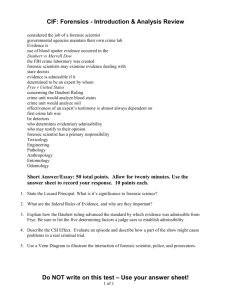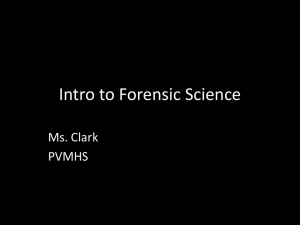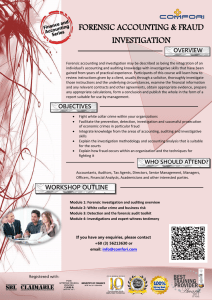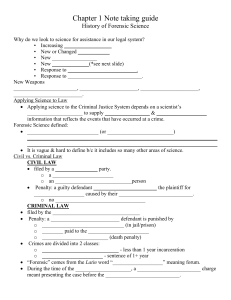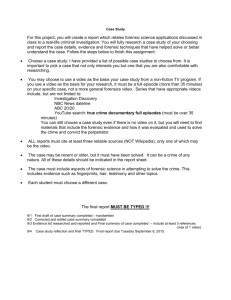Forensic Science History
advertisement
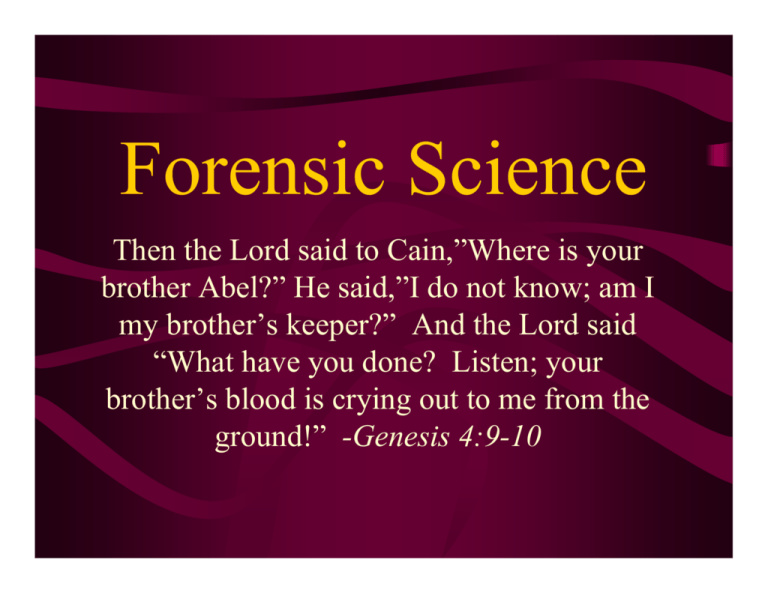
Forensic Science Then the Lord said to Cain,”Where is your brother Abel?” He said,”I do not know; am I my brother’s keeper?” And the Lord said “What have you done? Listen; your brother’s blood is crying out to me from the ground!” -Genesis 4:9-10 What Is Forensic Science? Definition – Relating to the use of science or technology in the investigation and establishment of facts or evidence in a court of law. Source – From the Latin word Forum. The Forum was a public gathering place during Roman times, where judicial activities and public business was conducted. History of Forensic Science Many people believe that Arthur Conan Doyle was the first to popularize forensic science with his Sherlock Holmes novels. The first, A Study in Scarlet, was published in 1887. Mathieu Orfila (1787-1853) • Spanish born but did work in France • Father of Forensic Toxicology • 1814 published a Treatise on the detection of poisons Alphonse Bertillon (1853-1914) • French Scientist • 1879 devised first system of person ID using a series of body measurements • Devised the first crime scene kit – still used today Anthropometry • The Bertillion system relied on a detailed description and measurement of the subject. • Eleven measurements were necessary. • These included height, reach, width of head, and length of foot. The down fall of Anthropometry occurred in 1903 at Leavenworth Federal Prison. A prisoner named Will West was brought to the prison and had his measurements taken. His measurements matched a prisoner already in the prison named William West. Despite the system there was no way to tell the two apart. The only noticeable difference between the two men was their fingerprints. Thus the Anthropometry was abandoned and the fingerprint (Henry) system was adopted. Will West William West Francis Galton (1822-1911) • British Scientist. • 1892 published the book “Finger Prints” which contained the 1st statistical proof supporting the uniqueness of fingerprints. • Laid the foundation of modern fingerprints. Karl Landsteiner (1868-1943) • Austrian who immigrated to the U.S. • 1901 Discovered human blood could be grouped into different categories (A, B, AB and O). • 1930 Won Nobel Prize. • 1940 helped to discover the Rh factor in human blood. Leone Lattes (1887-1954) • Italian Scientist • 1915 devised a procedure by which dried bloodstains could be grouped as A, B, AB or O • His procedure is still used today by some forensic scientists Calvin Goddard (1891-1955) • U.S. Army colonel • Developed the Comparison Microscope • Refined the techniques of determining if a gun had fired a specific bullet. (Ballistics) Albert S. Osborn (1858-1946) • American Scientist. • 1910 published the book “Questioned Documents.” • The book became a primary reference for document examiners. Hans Gross (1847-1915) • Lawyer and Judge in Austria • 1893 Published the first treatise on applying science to criminal investigation • Started the forensic journal “Kriminologie” Edmond Locard (1877-1966) • 1910 set up the first Forensic Lab in Lyons, France • Founder and Director of the Institute of Criminalistics @ the University of Lyons • Formulated the Locard’s Exchange Principle Locard’s Exchange Principle • When a criminal comes in contact with an object or person, a cross-transfer of evidence occurs • The criminal either removes something from the crime scene or leaves something behind • Either way this exchange can link the criminal to the crime scene Paul Kirk (1902-1970) • U.S. scientist that applied biochemistry to forensics • 1950 Head of the Crime Dept @ U of Cal school of Criminology • 1953 published “Crime Investigation”, a handbook for lab techniques J. Edgar Hoover (1895-1972) Director of the FBI (1924-1972) • FBI was established in 1905 by Teddy Roosevelt as the Bureau of Investigation • 1924 National Fingerprint file organized • 1932 Crime Lab Established • 1935 National Police Academy formed • 1935 Bureau renamed FBI


